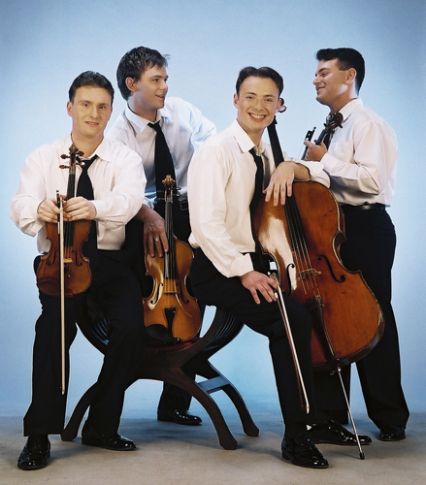Jerusalem Quartet displays tonal beauty and artistic intensity at Four Arts

The Jerusalem String Quartet performed Sunday afternoon at the Society of the Four Arts In Palm Beach.
Few chamber ensembles produce the sheer beauty of tone of the Jerusalem String Quartet. The four young musicians, who performed Sunday at the Society of the Four Arts in Palm Beach, present a corporate tone that practically glistens, led by the seamless, honeyed playing of first violinist Alexander Pavlovsky.
While some of our most eminent—and venerable—chamber ensembles allow defects of intonation and tone production, with unevenness of line and just plain scratchiness, to mar their performances, there wasn’t a trace of this from the Jerusalem ensemble. And they combined their first-class technical skills with an intense but interpretively flexible approach to the music that produced an excellent concert of Beethoven, Shostakovich and Brahms.
Beethoven’s early String Quartet No. 2 may be rooted in the classical form established by Haydn but it contains lots of brio, and the Jerusalem musicians uncovered every bit of it. Pavlovsky was particularly impressive in the first movement, rocketing up the E string in fast triplets that in his hands became the climactic notes they should be. The third and fourth movements moved with agility and lightness. Yet the musicians brought a forcefulness and weight to the last movement, giving the opening theme a clipped precision but then quickly plunging into the near-orchestral scale at which they seemed particular adept.
Shostakovich’s String Quartet No. 4 contains less of the anguish, dark shadows and sardonic humor of the composer’s other works in the form. Heard much less frequently than the other two quartets on the program, this work brought out the Jerusalem ensemble’s best qualities—the technical sureness, richness of tone and deep musical concentration.
They brought the first movement through its moody, constantly changing harmonies to a powerful climax before letting it die out. The second movement provided an opportunity for the shining violin playing of Pavlovsky, whose account of the long song-like melody was warm, melancholy and evocative, joining well in a quasi duet with the darker tones of cellist Kyril Zlotnikov. In the next movement, Zlotnikov and violist Ori Kam displayed an adeptness at galloping melodies that cut easily through the surrounding sound of the other musicians, thanks also to Shostakovich’s transparent string writing. The strange last movement, with its air of mystery and subdued ending, came to a great climax, with a brilliant, crashing chords accompanying the first violin’s agitated melody, and second violinist Sergei Bresler contributing sonorous broken chords to the sound, before the music died out.
Given the ardor they had poured into the Beethoven and Shostakovich quartets, one feared their intensity would overwhelm the autumnal Viennese tone of the Brahms String Quartet No. 2. Not the case, as it turned out. They took the first movement at a moderate tempo and brought a relaxed feel to the nostalgic second theme. The second movement’s melody in the violin took place over an accompaniment that was tonally rich without becoming too heavy, with the musicians bringing a tense excitement to the dramatic middle section, in which the violin snaps out clipped phrases over tremolos in the other instruments. The Israeli musicians also brought a tone of mystery and tension to the third movement, and the last movement came off with a fine, controlled tension and power.
Posted in Performances
Leave a Comment
Mon Mar 12, 2012
at 11:26 am
No Comments




